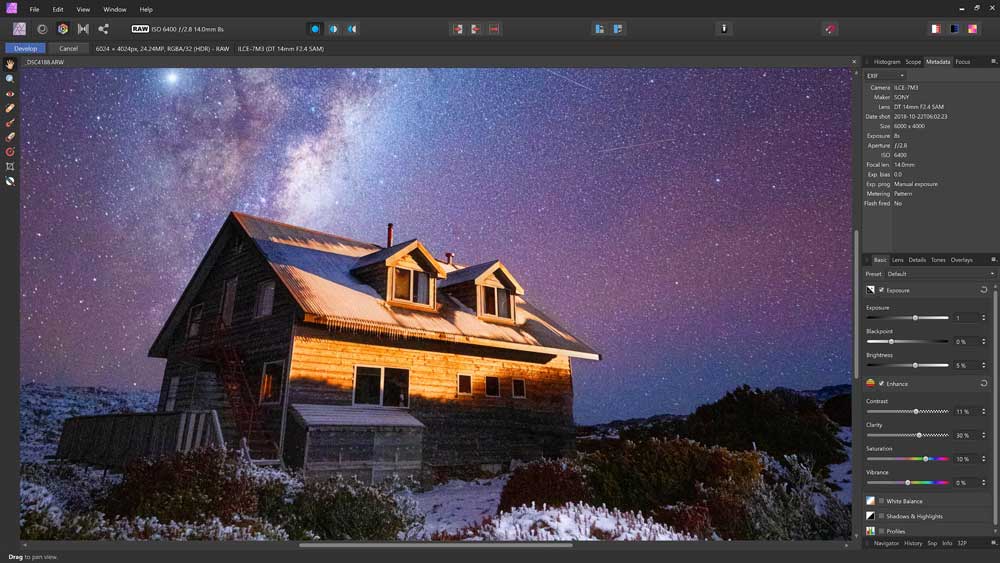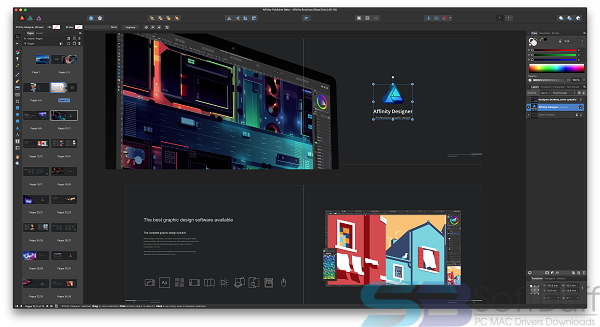Affinity Photo 1.8
- Affinity Photo 1.8 new features & improvements: Template support – save documents as template files to re-use time and time again, share templates across all apps and even access files on multiple.
- Affinity Photo has become the first choice for photography and creative professionals around the world, who love its speed, power and precision. Born to work hand-in-hand with the latest powerful computer technology, it’s the only fully-loaded photo editor integrated across macOS, Windows and iOS.
- Affinity apps are the first professional creative applications to offer native M1 support With our apps now primed for this transition, Mac customers with M1 can expect a more responsive user experience with respect to painting, pixel editing, filter effects, document rendering and more.
Affinity Photo 1.8 is here, and as usual is free to existing users on the platform(s) you have purchased a license for. Read our handy guide—How to install Affinity updates—if you need any help updating.
Affinity Photo version 1.8 includes bug fixes and optimisation but is much more geared towards compatibility and improved functionality in certain areas. Another important upgrade was HDR / EDR monitor support.
Let’s take a look at what’s new in Affinity Photo 1.8…
1. PSD Smart Object import
This feature is one we know a lot of you have been waiting for. Affinity Photo has always been able to import (and export) PSD documents, but now it can also import smart objects. Smart objects are converted to ‘embedded documents’ and a similar workflow can be applied: simply select the embedded document layer and choose Edit document on the context toolbar (or double click on the layer thumbnail) to open the smart object in a new tab. This is commonly used for mockups where you can drop in your own imagery, then go back to the parent document and see your design with the correct perspective.
2. Manual lens corrections
Previous versions of Affinity Photo offered automatic lens corrections, but 1.8 offers a complete manual override, allowing you to apply any lens profile correction you wish. This is a boon for photographs taken with manual lenses (no electronic connection) as they don’t communicate lens data to the camera, and it’s also useful for lenses that are adapted to other camera bodies, since the adapters will often change the lens ID which prevents it from being automatically identified.
3. Enhanced plugin support
Another feature new to Affinity Photo 1.8 is one a lot of you have asked for—improved plugin support, especially for the new Nik collection, where you can now work with wide colour spaces and enjoy full functionality with 16-bit precision documents.
4. Improved RAW processing for batch processing
Affinity Photo’s RAW development has undergone quite the transformation since its initial debut in version 1.4—it’s had some notable improvements, some of which are explored in the article What’s new with RAW in Affinity Photo 1.7?. Up until now, though, those improvements have been restricted to the development of single RAW files when loaded into the Develop Persona.
With version 1.8, however, you can now take advantage of 32-bit output, removal of the default tone curve, improved demosaicing, improved noise reduction, automatic lens corrections and wide colour space support when using RAW files with batch processing.
Here are a couple of workflow examples:
- Panorama stitching: if you set the RAW Output Format to 32-bit on the Develop Assistant, you can then batch process to 32-bit TIFF files (don’t forget to change the output format for the TIFF export options) and stitch those TIFFs. Because 32-bit is an unbounded pixel format, you don’t have to worry about clipping highlights or losing valuable pixel data, and you can tone map your finished panorama, giving you complete control over its tonality.
- Statistical stacking: astrophotography is a great example where you absolutely need all the precision you can muster. You can take the same approach as with panorama stitching by processing to 32-bit TIFFs and then adding them to a new stack. This allows you to take advantage of the extra precision for the tonal stretching required with astrophotography processing.
5. Selection Brush antialiasing
The powerful Selection Brush Tool now has a new option which is enabled by default, and it’s called Soft edges. Whenever you create a selection using this brush, when you release the mouse button to commit the selection some quick edge analysis is performed and the selection becomes ‘matted’ or antialiased. This is an incredible timesaver because it negates the need to jump into selection refinement for quite a number of use cases. Previously, even if you were cutting out a straightforward object with distinct edges, you would often need to use selection refinement to avoid having a ‘jagged’ cutout—now, simply create your selection, add a mask and you’re done!
You can of course disable ‘Soft edges’ on the context toolbar if you prefer a selection comprised of absolute pixels (e.g. for selecting shapes or working with pixel art).
And that’s not all…
OK, so this is more than five things, but I’d also like to draw your attention to these nice little additions to Affinity Photo 1.8…
Enhanced brush modifier
This little-known feature is incredibly useful for brush-based workflows, especially architecture workflows where you need to quickly create oval brushes for blocking in shadow detail.
With a brush tool selected, holding Ctrl+Alt (macOS) or Alt+Right click (Windows) then dragging with left-click will offer you the usual modifier to alter the brush Width and Hardness. All fairly standard so far. However, if you single click on the left mouse button, you will now toggle to Shape and Spacing instead. As mentioned above, this allows you to quickly create a ‘squished’ or oval brush shape. Single-clicking again will toggle to Rotation, then another single click will move back to Width and Hardness.
Between these three modifier options, you have an expanded amount of control over your brush properties without ever leaving your canvas.
Affinity Photo 1.8.5
Improved New Document dialog with templates (available in all 1.8 updates)


A new feature found across all Affinity apps is the redesigned New Document dialog, with intuitive categories for common presets and a brand new Templates section—this new template feature allows you to install third party templates and create your own from existing documents.
Metadata editing
Previously, Affinity Photo would read image metadata, but its editing capabilities were somewhat restricted—in 1.8, however, you can now edit file information, IPTC details, copyright declarations and other important fields during the editing process. Metadata import is now more robust too, ensuring vendor-specific tags are not lost when images are brought into Affinity Photo.
Canon CR3 RAW file support
Widely requested by many users, Canon’s new CR3 RAW format is now supported for RAW development: CR3 is used by Canon’s newer cameras such as the 90D, 250D, M50 and new mirrorless EOS R, Ra and RP models to name a few.
Many other improvements and fixes
It wouldn’t be a major point release without tons of quality-of-life improvements! Here’s a list of the most impressive upgrades:
- High intensity colours are now supported when compositing with filter effects (HDR authoring)
- New stock brushes, including a masking set for quick and easy compositing
- (macOS) A unified toolbar which increases working real estate on your screen
- The ability to read XMP sidebar metadata (copyright information, image tagging) when developing RAW files
- Selecting a mask now automatically toggles to a greyscale colour model, then toggles back to the previous colour model once another layer is selected
- PSB import stability has been improved
- The HSV colour model has been reintroduced to the HSL adjustment dialog, giving you more control over how colour saturation is applied
- Improved JPEG encoding for better quality at reduced file sizes
Watch more tutorials
Did you know that we have a fantastic range of video tutorials for Affinity Photo?
Find out more about our 1.8 updates
Not got Affinity Photo yet?
If you are thinking about trying out Affinity Photo, head over to our main website to find out more…
Enhance the quality of your photos by turning to this comprehensive application that can help edit and retouch your projects in an efficient manner
What's new in Affinity Photo 1.9.4.1048 Beta:
- Added 'Limit Initial Zoom to 100%' preferences option (defaulted to off)
- Fixed crash on document load when the OpenCLOn12 compatibility pack has been installed
- Added hardware acceleration to Gradient Map adjustment
- Fixed renaming a LUT preset to also change the name of the underlying ColourCubeRGB (so it manifests as expected in the LUT adjustment dialog)
Working as a photographer can be a tedious job, especially if you have to perform various editing on your material and have no appropriate tools that can simplify your work.
Fortunately, nowadays there is a broad range of specialized third-party software solutions that can help you achieve quick, convenient results in almost any situation. Affinity Photo is one of them.
Huge selection of tools
Affinity Photo can help you edit your photo or retouch it in various manners by providing you with an outstanding palette of features.
Some of them include classic photo manipulation tools, such as a brush, an eraser, a blur tool, a clone tool, a healing tool, a pen, text boxes, magnifying glass and paint bucket, but also more complex ones.
Traditional filters
The application encompasses multiple filters that can be found by navigating to the 'Filters' menu. They are organized in several categories, making them easy to access.
Categories include 'Blur,' 'Sharpen,' 'Distort,' 'Noise,' 'Detect' and 'Colors', but there are also some standalone entries, such as 'Frequency Separation,' 'Apply Image,' 'Lighting,' 'Shadows/Highlights,' 'Haze Removal' and 'Plugins'.
Sample files
Shortly after launching Affinity Photo, you are greeted by a splash screen that provides you with basic information regarding new projects.
To be more specific, you can create new documents by pressing the dedicated button, open existing projects from your computer or download some of the sample files available and test the program's capabilities on them. Most of the samples have moderate sizes, but a couple of them are rather large (over 300 MBs).
Reliable photo editing, manipulation and retouching tool

All things considered, Affinity Photo is a handy application that can help you edit, retouch or manipulate photos on your computer without significant efforts. It comes with a comprehensive user interface, packs an outstanding amount of functions and provides you with a bunch of sample files that you can test this app's features on.
Filed under
Affinity Photo was reviewed by Vlad Constantinescu- 90-day trial
Affinity Photo 1.9.2.1035 / 1.9.4.1048 Beta
add to watchlistsend us an updateAffinity Photo 1.8.6 Download
- runs on:
- Windows 10 64 bit
Windows 8 64 bit
Windows 7 64 bit - file size:
- 528 MB
- filename:
- affinity-photo-1.9.2.exe
- main category:
- Multimedia
- developer:
- visit homepage
top alternatives FREE
Affinity Designer
top alternatives PAID
